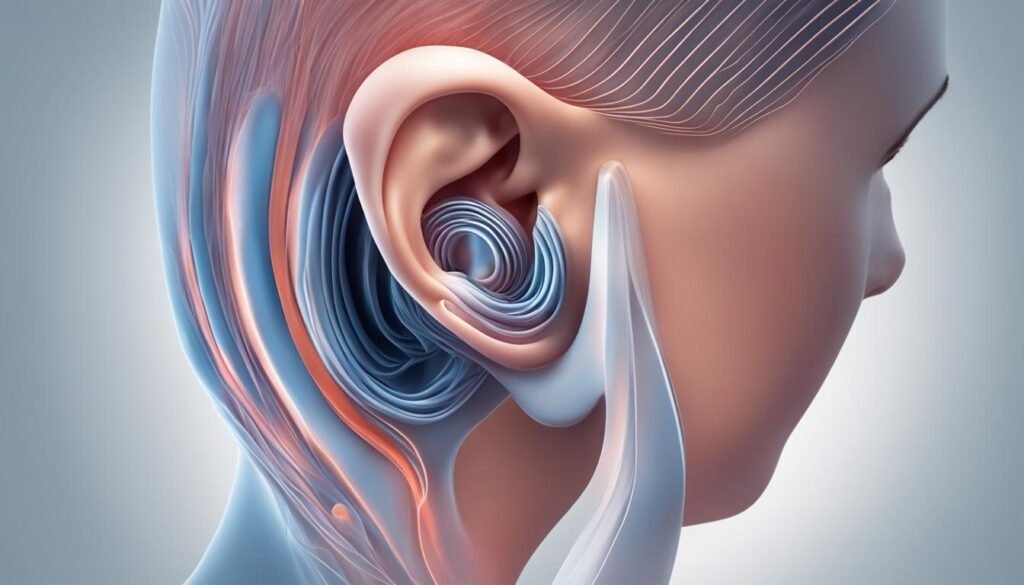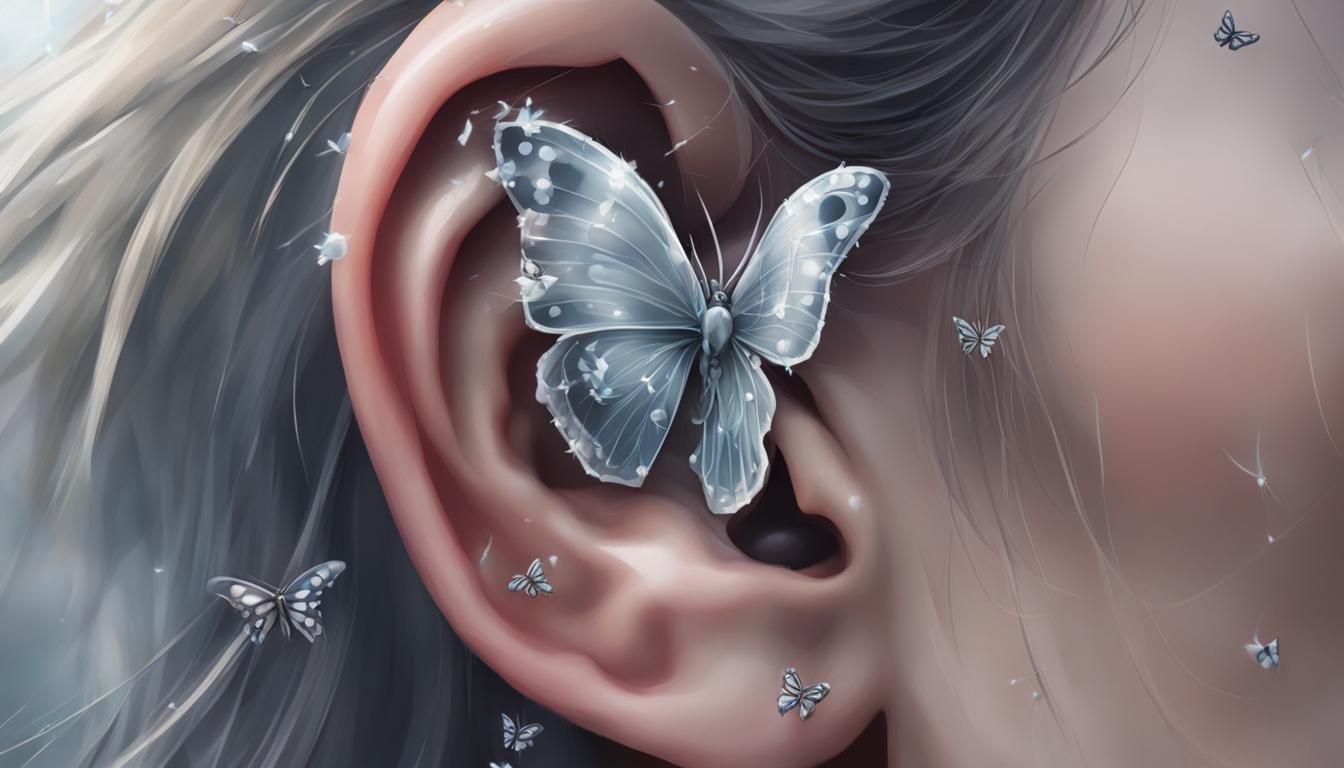Do you ever experience a fluttering sensation in your left ear and wonder what causes it? You’re not alone. Fluttering in the ear can be quite bothersome, but understanding its underlying causes can help alleviate your concerns. In this article, we’ll explore the various factors that can lead to ear fluttering and what you can do about it.
Key Takeaways:
- Fluttering in the ear can be caused by conditions such as tinnitus, dysfunction of ear tissues, and high blood pressure.
- Tinnitus, a common cause of ear fluttering, can manifest as clicking, buzzing, throbbing, and fluttering sounds.
- Other potential causes of ear fluttering include middle ear myoclonus, eustachian tube dysfunction, and excessive earwax.
- If you experience persistent fluttering in the ear or other concerning symptoms, it’s important to seek medical attention.
- Treatment options for ear fluttering depend on the underlying cause and may include managing tinnitus, addressing middle ear myoclonus or eustachian tube dysfunction, and treating related conditions.
Tinnitus as a Cause of Ear Fluttering
The sensation of fluttering in the ear can be attributed to various factors, and one common cause is tinnitus. Tinnitus is a condition characterized by the perception of sound without any external source. The sounds associated with tinnitus can include fluttering, clicking, buzzing, and throbbing in the ear.
Tinnitus can arise from different dysfunctions in the ear, such as tumors, Meniere’s disease, hearing loss, and exposure to loud noises. It can also be a consequence of underlying health conditions. When it comes to the treatment of tinnitus, there are several options available. Behavioral therapy is often used to help individuals cope with the symptoms of tinnitus and minimize its impact on daily life.
In addition to behavioral therapy, hearing aids can be beneficial for those with tinnitus. These aids help to amplify external sounds, which can provide relief from the perceived internal sounds of tinnitus. Medication may also be prescribed to manage tinnitus symptoms. Innovative techniques that utilize electromagnetic energy and implants are being researched and developed as potential treatment options for tinnitus.
It’s important to note that the treatment for tinnitus may vary depending on the underlying cause. Therefore, it is essential to consult with a healthcare professional for an accurate diagnosis and appropriate treatment plan.
Middle Ear Myoclonus and Fluttering Sounds
Middle ear myoclonus is a rare condition characterized by dysfunctional contractions of the muscles in the middle ear. These involuntary contractions can cause fluttering sounds in the ear, leading to discomfort and uncertainty for those experiencing this phenomenon. While fluttering sounds in the ear are often diagnosed as tinnitus, it is important to differentiate between the two conditions, as their causes and treatments differ.
The exact causes of middle ear myoclonus are not fully understood, but it can be idiopathic or develop after trauma, facial muscle spasms, or essential tremor of the soft palate. These muscular contractions can disrupt the normal functioning of the middle ear, leading to the perception of fluttering sounds.
Causes of Middle Ear Myoclonus
- Idiopathic – The cause is unknown, with no identifiable underlying condition or trigger.
- Trauma – Middle ear myoclonus can develop following head or ear trauma, which can disrupt the delicate structures in the middle ear.
- Facial Muscle Spasms – Abnormal muscle contractions in the face can sometimes extend to the middle ear, resulting in fluttering sounds.
- Essential Tremor of the Soft Palate – In rare cases, tremor in the soft palate can transmit vibrations to the middle ear, causing fluttering sounds.
Treatment for Middle Ear Myoclonus
Fortunately, there are treatment options available to alleviate the symptoms of middle ear myoclonus and improve your quality of life. The treatment approach may vary depending on the severity of the condition and the underlying cause. Some common treatment options for middle ear myoclonus include:
- Medication – Certain medications, such as benzodiazepines, carbamazepine, orphenadrine, and piracetam, may help reduce muscular contractions and alleviate fluttering sounds.
- Surgical Therapies – In severe cases, when conservative treatments are ineffective, surgical interventions like tympanectomy (removal of the eardrum) may be considered to address the abnormal muscle contractions.
If you are experiencing fluttering sounds in your ear, it is essential to consult with a healthcare professional for an accurate diagnosis and to discuss the most appropriate treatment options for your specific condition.

Eustachian Tube Dysfunction and Fluttering Sensation
Eustachian tube dysfunction occurs when there is swelling or an inability to open and close the eustachian tube properly. This can cause symptoms such as fluttering sounds in the ear, muffled hearing, ringing in the ears, and a feeling of fullness in the ear. There are several possible causes of eustachian tube dysfunction.
Causes of Eustachian Tube Dysfunction:
- Upper respiratory tract infections
- Allergies
- Tumors
- Ear injuries
Eustachian tube dysfunction can be the result of these factors and can lead to the fluttering sensation in the ear. It is important to note that if you experience persistent fluttering in the ear or any other concerning symptoms, it is recommended to seek medical attention for a proper diagnosis and treatment.
Treatment for Eustachian Tube Dysfunction:
- Swallowing, yawning, or chewing gum to help open the eustachian tubes
- Forced exhalation technique (Valsalva maneuver)
- Nasal douching with saline solution to relieve congestion
- Decongestants to reduce swelling
- Antibiotics if there is an infection present
- Surgical procedures such as pressure-equalizing tube insertion in severe cases
Treatment for eustachian tube dysfunction aims to alleviate symptoms and restore proper functioning of the eustachian tubes. Your healthcare provider will determine the most suitable treatment plan based on the underlying cause and severity of your condition.
Fluttering sounds in the ear can be a sign of eustachian tube dysfunction. It is advisable to consult a healthcare professional for an accurate diagnosis and appropriate treatment options. Eustachian tube dysfunction can be managed effectively with various techniques and medications, depending on the specific cause and severity of the condition.
Patulous Eustachian Tube and Fluttering in the Ear
If you are experiencing a fluttering sensation in your ear, it may be a result of a condition known as patulous Eustachian tube dysfunction. This occurs when the Eustachian tube, which connects the middle ear to the back of the throat, remains open most of the time. As a result, you may experience symptoms such as hearing your own voice or breathing, echoing sounds, and a feeling of fullness in the ear. While the exact cause of patulous Eustachian tube dysfunction is unknown, it has been associated with factors such as weight loss, pregnancy, and certain medications.
Treatment options for patulous Eustachian tube dysfunction aim to alleviate the symptoms and improve the function of the Eustachian tube. One approach is to adopt positional changes such as reclining or lowering the head between the knees, as this can help close the Eustachian tube temporarily. Additionally, nasal sprays or drops may be prescribed to decrease nasal congestion and help manage the symptoms. In severe cases, surgical intervention may be considered to address the dysfunction.

Causes of Patulous Eustachian Tube Dysfunction:
- Weight loss: Rapid weight loss or a low body mass index (BMI) can increase the risk of developing patulous Eustachian tube dysfunction.
- Pregnancy: Hormonal changes during pregnancy can affect the function of the Eustachian tube, leading to patulous Eustachian tube dysfunction.
- Medications: Certain medications, such as diuretics, can have an impact on the Eustachian tube function and contribute to the development of patulous Eustachian tube dysfunction.
Treatment for Patulous Eustachian Tube Dysfunction:
- Positional changes: Adopting different positions, such as reclining or lowering the head between the knees, can help close the Eustachian tube temporarily and alleviate symptoms.
- Nasal sprays or drops: Nasal decongestants or saline solutions can help reduce nasal congestion and improve Eustachian tube function.
- Surgical intervention: In severe cases where conservative measures are not effective, surgery may be considered to address the underlying dysfunction of the Eustachian tube.
Meniere’s Disease and Fluttering in the Ear
Meniere’s disease is a chronic disorder of the vestibular system, which controls balance and equilibrium. It is characterized by recurring episodes of vertigo, tinnitus, fluctuating hearing loss, and a feeling of fullness in the affected ear. The exact cause of Meniere’s disease is unclear, but it is thought to be related to a combination of factors, including circulation problems, viral infections, allergies, autoimmune reactions, and even genetic predisposition.
The symptoms of Meniere’s disease can be debilitating and significantly impact a person’s quality of life. The unpredictable nature of the episodes can make it challenging to carry out daily activities and may cause anxiety and stress. Although there is currently no cure for Meniere’s disease, various treatment options can help manage the symptoms and reduce the frequency and severity of episodes.
Treatment for Meniere’s Disease
- Medication: Doctors may prescribe diuretics to reduce fluid buildup in the inner ear, as well as anti-nausea medications to alleviate vertigo symptoms.
- Lifestyle changes: Adopting a low-sodium diet, avoiding triggers such as caffeine and alcohol, and managing stress can help minimize the frequency and intensity of Meniere’s disease episodes.
- Vestibular rehabilitation therapy: This form of physical therapy focuses on exercises and techniques to improve balance and reduce the impact of vertigo on daily activities.
- Meniett device: This small device delivers pulses of pressure to the middle ear to improve fluid circulation and reduce symptoms.
- Surgery: In severe cases that do not respond to conservative treatments, surgical options such as endolymphatic sac decompression or vestibular neurectomy may be considered.
It is important for individuals with Meniere’s disease to work closely with their healthcare providers to develop a personalized treatment plan that addresses their specific symptoms and needs. By managing the condition effectively, many people with Meniere’s disease are able to lead fulfilling lives and minimize the impact of the disease on their day-to-day activities.
Conclusion
Experiencing fluttering in the ear can be an annoying symptom, but in most cases, it is not a cause for alarm. However, if you notice persistent fluttering in the ear or other concerning symptoms like impaired hearing, high blood pressure, or hypothyroidism, it is important to seek medical attention for a proper diagnosis and treatment.
The treatment options for fluttering in the ear depend on the underlying cause. For managing tinnitus-related fluttering, behavioral therapy, hearing aids, medication, and innovative techniques using electromagnetic energy and implants can be considered. In the case of middle ear myoclonus, medication and surgical therapies like tympanectomy may provide relief. And for eustachian tube dysfunction, strategies such as swallowing, nasal douching, decongestants, and surgical procedures can be helpful.
In addition to addressing the specific conditions causing the fluttering sensation, it is important to consider general ear health. Removing excessive earwax, managing high blood pressure, treating sinus infections, and maintaining good overall health can further support the resolution of fluttering in the ear.
Remember, everyone’s situation is unique, and it’s best to consult with a healthcare professional for an accurate diagnosis and personalized treatment plan. With the right approach, you can find relief from ear fluttering and improve your overall ear health.
FAQ
Why is my left ear fluttering?
Left ear fluttering can be caused by various factors, including conditions such as tinnitus, middle ear myoclonus, eustachian tube dysfunction, and patulous eustachian tube. It is important to identify the underlying cause and seek appropriate medical attention for proper diagnosis and treatment.
What is tinnitus?
Tinnitus is a condition characterized by the perception of sound without an external stimulus. It can manifest as fluttering, clicking, buzzing, or throbbing sounds in the ear. Tinnitus can be caused by dysfunctions in the ear, such as tumors, hearing loss, and exposure to loud noises. Treatment options for tinnitus include behavioral therapy, hearing aids, medication, and innovative techniques using electromagnetic energy and implants.
What is middle ear myoclonus?
Middle ear myoclonus is a rare condition characterized by dysfunctional contractions of the muscles in the middle ear. It can cause fluttering sounds in the ear, often diagnosed as tinnitus. Middle ear myoclonus can be idiopathic or develop after trauma or muscle spasms. Treatment options include medication and surgical therapies.
What is eustachian tube dysfunction?
Eustachian tube dysfunction occurs when there is swelling or an inability to open and close the eustachian tube properly. It can cause symptoms such as fluttering sounds in the ear, muffled hearing, ringing in the ears, and a feeling of fullness. Eustachian tube dysfunction can be caused by upper respiratory tract infections, allergies, tumors, and ear injuries. Treatment options include various techniques and surgical procedures.
What is patulous eustachian tube?
Patulous eustachian tube is a type of eustachian tube dysfunction where the tube stays open most of the time. It can cause symptoms such as hearing one’s own voice or breathing, echoing sounds, and a feeling of fullness. The exact cause is unknown, but it may be associated with weight loss, pregnancy, and certain medications. Treatment options include conservative measures, drugs, and surgery in severe cases.
What is Meniere’s disease?
Meniere’s disease is a chronic disorder of the vestibular system, which controls balance and equilibrium. It can cause symptoms such as dizziness, tinnitus, hearing loss, and ear pressure. The exact cause is unclear, but potential factors include circulation problems, viral infections, allergies, and possible genetic disorders. Treatment options include various approaches to manage symptoms and improve quality of life.
How can I treat fluttering in the ear?
Treatment options for fluttering in the ear depend on the underlying cause. It is important to seek medical attention for proper evaluation and diagnosis. Treatment may include managing tinnitus, addressing middle ear myoclonus or eustachian tube dysfunction, removing excessive earwax, managing high blood pressure, and treating related conditions like sinus infections.

